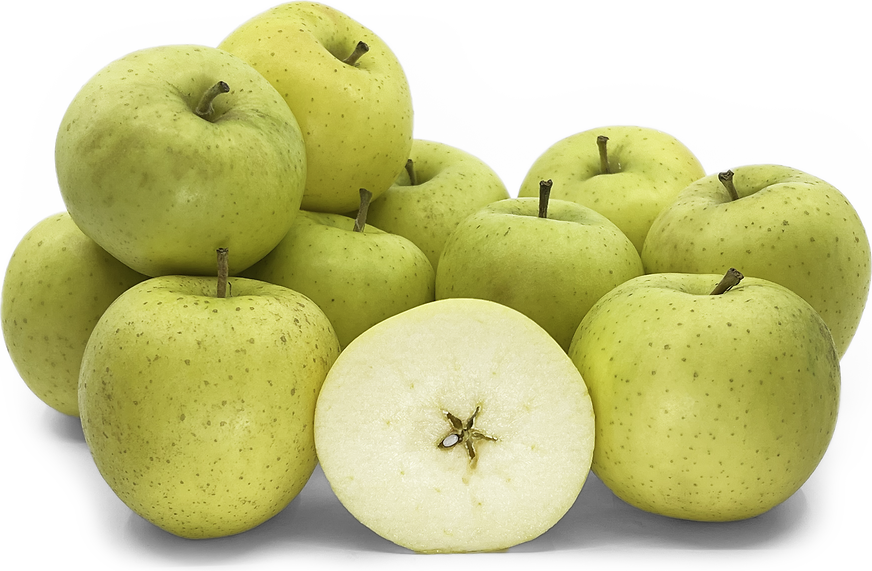


Toki Apples
Estimated Inventory, lb : 0
Description/Taste
Toki apples are a small to medium-sized varietal, averaging 300 to 550 grams in weight, and have a uniform, round to conical shape with broad, flat shoulders tapering to a narrow base. The apple's skin is smooth, taut, and firm with prominent grey-brown lenticels, ripening from green to a golden-yellow hue with pale green undertones. Depending on cultivation conditions, the skin may also showcase patches of a faint red-coral blush on the side most exposed to the sun. This blush is often translucent and diffuses softly across the surface. Underneath the semi-thin skin, the white-to-ivory flesh is crisp, dense, and aqueous with a delicate crunch. The flesh also encases a central core filled with tiny, black-brown seeds. Toki apples are aromatic and are known for their very sweet flavor mixed with a tart, mild acidity.
Seasons/Availability
Toki apples are available in the fall through winter in Japan.
Current Facts
Toki apples, botanically classified as Malus domestica, are a Japanese variety that belongs to the Rosaceae family. This modern cultivar was bred for its sweet flavor, unique coloring, and crisp flesh, and is a cross between Japanese fuji and ourin apples. Toki apples are named after their original breeder in the Aomori prefecture and are considered to be an improved variety created to expand the yellow apple market in Japan.
Nutritional Value
Toki apples are a good source of fiber, which can help regulate digestion, and contain vitamins A and C, which are antioxidants that can boost the immune system and protect against external aggressors. The apples also provide smaller amounts of potassium, iron, and calcium.
Applications
Toki apples are best suited for raw applications as their sweet-tart flavor is showcased when consumed fresh, out-of-hand. The yellow-green fruits can be quartered and displayed on appetizer plates with nuts, cheeses, and dried fruits, thinly sliced and layered into sandwiches, grated into a crunchy slaw, utilized whole and dipped in candy coatings or caramel as a dessert, or chopped and tossed into green and fruit salads. Toki apples can also be pressed into juices or ciders, blended into smoothies, baked into pies, tarts, muffins, or cakes, cooked into rice-based dishes with roasted meats, or stewed into jams, preserves, and compotes. Toki apples pair well with fruits such as pears, grapes, bananas, and oranges, celery, cucumber, yogurt, ginger, miso, potatoes, and rice. The fresh fruits will keep 1-2 months when wrapped in newspaper or stored whole and unwashed in a plastic bag in the crisper drawer of the refrigerator.
Ethnic/Cultural Info
Toki apples are heavily promoted by the Aomori Prefectural Apple Countermeasures Council in Japan as a new yellow apple cultivar. Historically, yellow apples were very rare in local markets and were often overshadowed by red apple cultivars. To increase visibility, the variety was declared the most recommended apple in 2014 in the Aomori prefecture, and in the present-day, the council is using new marketing strategies of encouraging consumers to purchase directly from growers. In Aomori, Hirosaki Park is a large orchard that contains over sixty-five different apple cultivars and is open to the public for apple picking. Visitors can harvest fruits from over 1,300 different trees, and there are guided tours, apple contests, and educational talks to create a well-rounded experience. In addition to the orchards and activities, there is also a store known as the “Ringo No Le” that sells apple goods from pastries, candies, fresh fruits, jams, to ciders.
Geography/History
Toki apples were developed by breeder Toki Denshiro in the Aomori prefecture in Japan. It took Denshiro over twenty years to create the new cultivar, and Toki apples were registered as a commercial variety in 2004. Today Toki apples are still primarily cultivated in the Aomori prefecture, but they are also grown on a smaller scale in the Nagano and Akita prefectures, sold at fresh markets across the country.
Recipe Ideas
Recipes that include Toki Apples. One
| My Fussy Eater |
|
Banana, Avocaod & Apple Baby Muffins |
| Simply Blended Smoothies |
|
Green Apple Avocado Green Smoothie |
| Green Healthy Cooking |
|
Green Apple Salmon Avocado Salad |

















